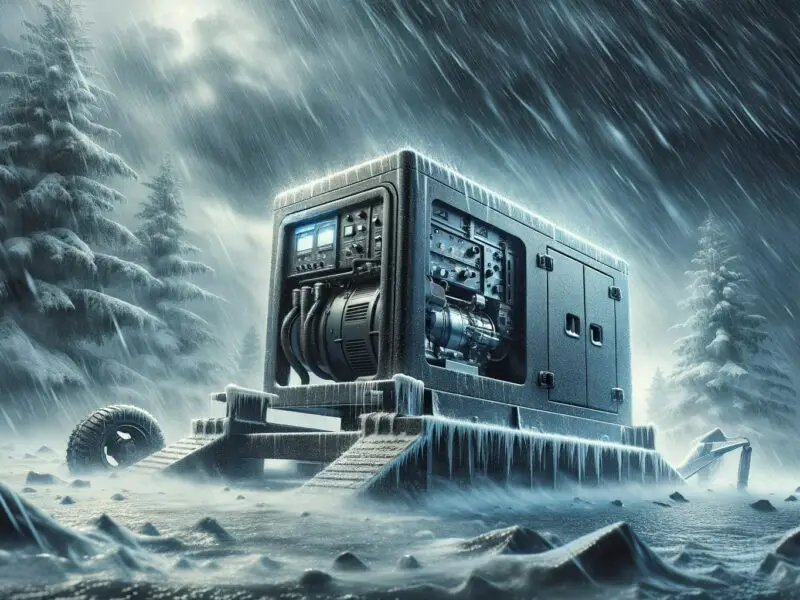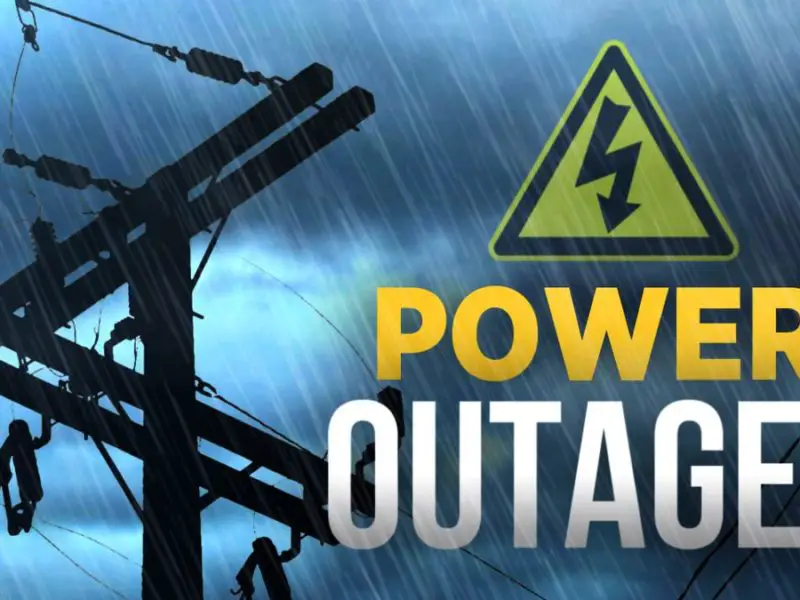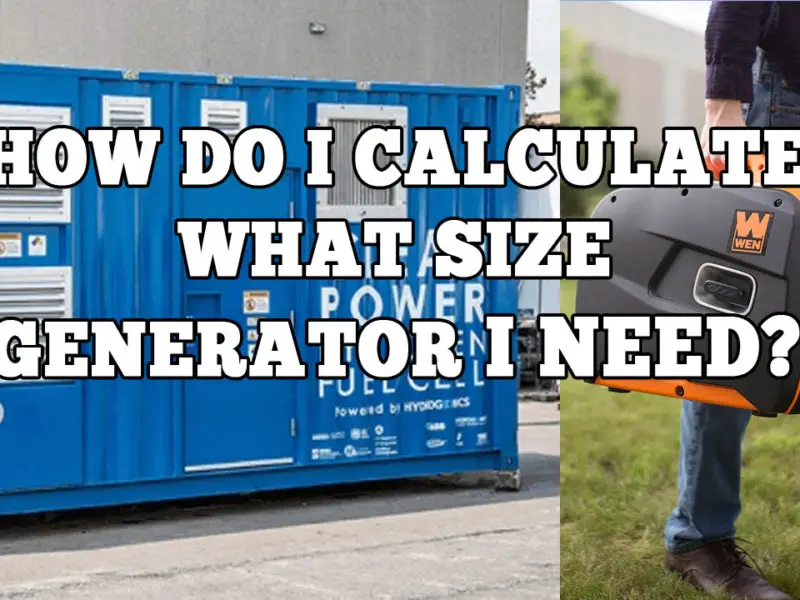Electric power generators are crucial standalone equipment that provides electricity when grid power is unavailable or impractical. For this reason, the power generator is found everywhere, from homes to offices and even commercial facilities, where they serve as a reliable backup power solution or a primary power source.
But have you ever wondered how the typical electric power generator works? How does it transform gasoline or heating oil to electricity? It would be nice to know in case the generator breaks down in the middle of the night and you have to troubleshoot it yourself. So, let’s find out how the entire process works.
Generators Don’t Actually Generate Electricity
First off, we must clarify that power generators don’t actually create electricity. They merely convert mechanical or chemical energy into electricity.
A generator converts mechanical/chemical energy into electric energy by capturing the power of motion and forcing electrons from the external source through an electric circuit. Once electric power is generated, it’s directed through copper wires to power connected devices, machines, and other electrical systems.
The standard generator operates on Michael Faraday’s principle of electromagnetic induction. Faraday discovered that electrical charges are created when a conductor moves through a magnetic field. He further proved that such charges could be directed to create a flow of current.
Thus, an electric power generator is nothing more than an electromagnet, i.e., a piece of wire next to a magnet that directs the flow of electricity.
The Parts of an Electric Power Generator
Now that we know what an electric power generator does and what it doesn’t, let’s find out what really goes on behind the curtains. The typical generator has eight main parts;
- Engine
- Alternator
- Fuel system
- Voltage regulator
- Cooling and exhaust systems
- Skid/frame
- Batteries
- Oil filters
- Control panel
- Air filter
Each of these parts plays a critical role in generating electricity. Here’s a summary of what each part does.
1. The engine
The engine is the source of the input mechanical energy to the generator, directly providing energy to the generator. Therefore, the size of the engine determines the amount of electricity the generator can produce per unit of time.
There are a couple of things you should know about generator engines;
- Type of fuel used
Not all engines use the same fuel. While the majority run on gasoline, others use propane, natural gas, or even diesel. Smaller engines tend to run on gasoline, while the bigger models run on diesel, propane, or natural gas. Some engines, known as bi-fuel engines, even run on two fuels at a go, typically diesel and gas.
- OHV vs. non-OHV engines
Secondly, generator engines also come in two main categories, i.e., overhead valve (OHV) and non-overhead valve (non-OHV). The main difference is that, in OHV power engines, intake and exhaust valves are located in the head of the engine’s cylinder. This is different from non-OHV engines that have the valves mounted on the engine block.
OHV generator engines are more expensive than their non-OHV counterparts. However, they are also advantageous over non-OHV models in several ways, including;
- More compact design
- Enhanced durability
- Simpler operation
- Reduced noise output
- Low emission levels
The main reason OHV power generator engines are more durable is they are equipped with Cast Iron Sleeve (CIS) in the engine cylinder. The CIS reduces wear and tear, especially if you use your engine often or for long durations.
2. The Alternator
The alternator, also known as the genhead, is the part of the generator that produces electric output. It comprises an assembly of stationary and moving parts within a durable housing, which work together to cause relative movement between the magnetic and electric fields, resulting in electric current.
The two main parts of the alternator are the stator and rotor/armature. The stator is the primary static part of the alternator. It contains a set of electrical conductor coils wound over an iron core. Meanwhile, the rotor is the primary moving component. It generates the rotating magnetic field that ultimately produces an electric current.
The rotor produces an electric field in one of the three ways;
- By induction: Rotors that produce electric fields through induction are typically called brushless motors (thus brushless inducers) and are only found in large generators.
- Through permanent magnets: This is most common in small generators.
- Through an exciter: Exciters are tiny direct current sources that energize the rotor using an assembly of conducting slip rings and brushes.
Whichever the approach, the armature generates a moving magnetic field around the stator that induces/causes a voltage difference between the stator’s coils. This usually results in alternating current (AC).
Three key things are critical when assessing the suitability of an alternator;
- Housing material: Generator rotors have either plastic or metal housing. Of the two, metallic housings are more desirable as they’re more durable. Though functional, plastic rotor housings get deformed with time and quickly wear out, exposing the internal components.
- Needle bearing type: Alternators have either ball-bearings or needle bearings. Most engineers prefer ball bearings as they last longer.
- Brush vs. brushless design: Brushless induction rotors are far more efficient than models that use brushes. They also require less maintenance.
3. The fuel system
As we mentioned at the beginning, electric power generators use fuel to generate electricity. Therefore, a dedicated system is necessary to facilitate the introduction of fuel to the generator system, supply it to the various parts, and hold the fuel for as long as needed.
The fuel tank can be attached to the generator or exist separately as a standalone unit and typically keeps the generator operating for 6-8 hours. It connects to the rest of the generator via supply and return pipes. All generator fuel tank systems are subject to approval from relevant government and industry authorities.
A standard fuel system comprises the following features;
- The supply and return lines: The supply line is a network of pipes that ferry the fuel from the tank to the engine. Meanwhile, the return line directs fuel from the engine to the tank.
- Ventilation pipe for fuel tank: All fuel tanks have a ventilation system to prevent vacuums or pressure buildup when refilling or draining the tank.
- Fuel pump: The fuel pump is an electrically operated system that forces fuel from the tank to the engine.
- Fuel injector: The injector atomizes liquid fuel and sprays the atomized fuel into the engine’s combustion chamber in tiny amounts.
Two other important components of the fuel system are the overflow system (to facilitate safe fuel overflow) and the fuel/water separator /filter (to separate the fuel from foreign matter).
4. The voltage regulator
As the name suggests, the voltage regulator regulates the generator’s voltage output, with each part of the regulator system playing a specific role as follows;
- The voltage regulator: Converts AC current to DC current. It takes a small portion of the AC voltage created at the alternator (as we saw earlier), converts it to direct current, and then feeds the direct current to coils on the stator known as the exciter windings.
- Exciter windings: The exciter windings convert DC back to AC. This process is critical for rectifying the final DC current.
- The rotating rectifiers: The exciter windings are connected to rotating rectifiers designed to rectify the AC current before converting it back to DC current. This DC current is then fed to the armature to create an electromagnetic field.
- The rotor/armature: The armature converts DC current to AC voltage across the stator windings, causing the generator to produce a larger AC voltage output.
The cycle repeats over and over again until the AC generates enough voltage proportional to its capacity. Each time, the generator produces less and less current until it reaches a point where it produces just enough DC current to keep the generator operating at full capacity.
5. Cooling and exhaust system
The final major system in the power generator is the cooling and exhaust system. The two sections work as follows;
- Cooling
It’s natural for the generator to become extremely hot after running for an extended period. A cooling system built into it helps keep the temperature low enough to prevent damage to internal components and minimize fire risk.
Different generators have different cooling systems. For instance, the majority of large generators producing 2250kW and above use water. Meanwhile, others use hydrogen to cool the stator windings as hydrogen is excellent at absorbing heat than other coolants. The heat is then transferred through a heat exchanger into a secondary cooling station containing demineralized water.
However, for smaller applications, both commercial and residential, a standard fan and radiator are integrated into the generator and serves as the primary cooling system.
- Exhaust system
Exhaust refers to the fumes and unsafe gases, such as carbon monoxide, generated as gasoline or other fuels burn inside the generator to produce electricity.
Most generators employ a dedicated piping system to vent the gases. Exhaust pipes are typically made from cast iron, wrought iron, or steel and attached to the generator using flexible connectors to dampen vibrations. Exhaust pipes are designed to terminate or lead outdoors.
Other Key Parts
The generator has the following parts/systems that work in harmony with the five systems above to produce electricity safely and efficiently.
- The battery charger
The starting process of a generator is battery-powered. This is understandable considering that batteries provide a ready source of power. A battery charging system within the generator keeps the battery charged for future starts. It does so by supplying the battery with “float voltage” in just the right amounts to prevent under or overcharging. Battery chargers are made from stainless steel to prevent corrosion and are fully automatic.
- The lubrication system
All generators also have a lubrication system to keep the engine’s moving parts in the best shape. The lubricating oil is stored in a pump within the generator. It’s good practice to check the level of the lubricating oil every eight hours of generator operation and replenish it as directed by the manufacturer. For example, most manufacturers recommend an oil change every 5,000 hours. Additionally, make sure to check the pump periodically for leakage.
- The control panel
Finally, the generator’s control panel is the user interface where human users input instructions and view operational details. Most generators have at least three things on the control panel. First, you’ll almost always find an electric ON/OFF switch on the control panel. This switch allows you to turn the generator on and off.
Secondly, you’ll likely find various engine gauges on the control panel, including pressure, temperature, coolant, and battery gauges. Some generators even display engine rotation speed and duration of operation on the control panel.
Finally, modern power generator control panels may also display other controls, such as a phase selector, frequency, and engine control (auto, manual, etc.) switch.
How the Generator Works – Step-by-Step
Now that you understand the main parts of a power generator, below is how a standard generator works, step-by-step.
- You fill the generator with the relevant fuel as directed by the manufacturer. Never use a different fuel from what the manufacturer says.
- The engine uses the provided fuel to create mechanical energy.
- The alternator taps the mechanical energy from the engine to push electric charges through pre-defined circuits. The flow of electrons creates magnetic and electric fields.
- Meanwhile, the rotor generates a moving magnetic field around the stator. Remember that the stator contains stationary electrical conductors.
- The electric and magnetic fields confluence creates alternating current (AC) and then transfers it to the voltage regulator.
- The voltage regulator converts the AC to DC then back to AC for rectification. Then the AC current is converted to DC current and transferred to the rotor, where it’s converted to AC voltage.
- The AC voltage is then supplied to your home (and office) appliances, such as heaters, refrigerators, and lighting systems.
Summary
So, that’s how a power generator works in a nutshell. The only other thing we must mention is the main assembly/frame. All power generators have a housing system that provides structural base support and protects the internal components from damage.



